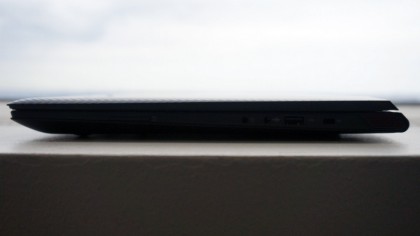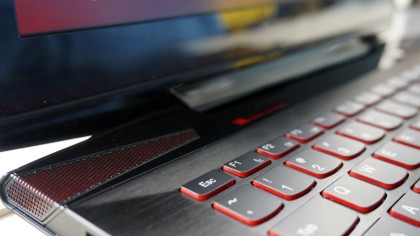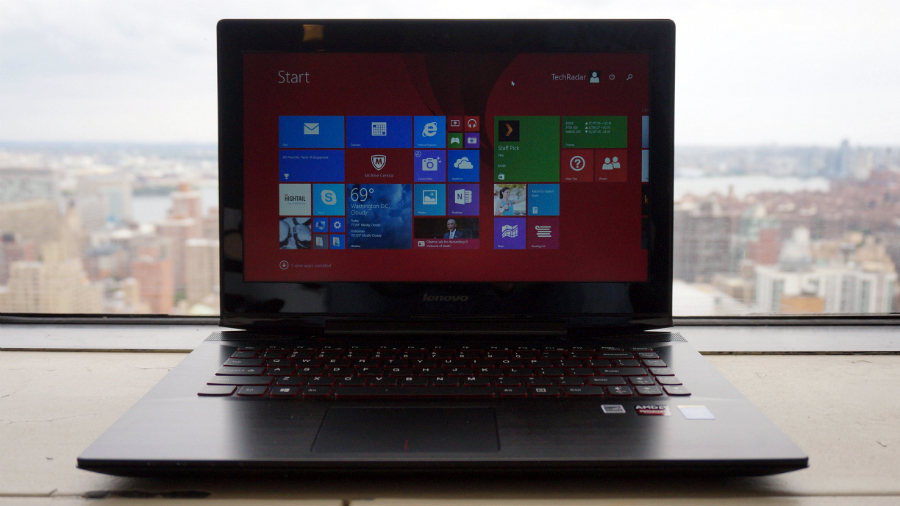Why you can trust TechRadar
The Lenovo Y40 starts at $699 (about £426, AU$790) and ranges up to $1299 (around £791, AU$1469) at the time of writing. The unit that I spent time reviewing is currently priced out at $999 (about £609, AU$1130).
The review unit configuration provided by Lenovo is listed below:
Spec sheet
- CPU: 1.8GHz Intel Core i7-4500U (dual-core, 4MB cache)
- Graphics: AMD Radeon R9 M275X (2GB GDDR5 RAM); Intel HD Graphics 4400
- RAM: 8GB DDR3L
- Screen: 14-inch, 1920 x 1080 FHD, anti-glare LED
- Storage: 256GB SSD
- Ports: 2 USB 3.0, 1 USB 2.0, combo mic/headphone jack, HDMI-out, 4-in-1 card reader, Ethernet, SPDIF
- Connectivity: Intel Dual Band Wireless-AC 3160, Bluetooth 4.0
- Camera: 720p HD webcam
- Weight: 4.85 pounds
- Size: 13.7 x 9.8 x 0.9 inches
Each of the configurations currently available have identical offerings (screen quality, build materials and speakers.) For the most part, the eight Y40 configurations offer little variance in terms of CPU and GPU performance and storage options for each price boost.
For the best value, go with the entry model. It matches our review unit's amount of RAM and GPU and better yet, it even has a slightly faster processor. Also, the stock 500GB SSHD hybrid drive offers more space, which for a gamer, movie or music buff, is valuable.
Performance
For a machine starting at such a low introductory price, the Lenovo Y40 puts up some respectable numbers. Here's how the machine performed under the weight of our synthetic tests:
Benchmarks
- 3DMark: Ice Storm: 45,024; Cloud Gate: 4,687; Fire Strike: 1,559
- Cinebench CPU: 213 points; Graphics: 49 fps
- PCMark 8 Home: 2,675 points
- PCMark 8 Battery Life: 3 hours, 54 minutes
- BioShock Infinite (1080p, Ultra): 14 fps; (1080p, Low): 44 fps
- Metro: Last Light (1080p, Ultra): 6 fps; (1080p, Low): 25 fps
Outside of benchmarks, the Y40 certainly has no problem performing standards tasks with ease. The optional SSD in our review unit assisted in making the already snappy Windows 8.1 experience even faster, booting and shutting down quickly. I'm confident, however, that you'd experience similar results with the standard SSHD hybrid drive on offer.
The amazing battery life will also keep you going for a long time in between charges. Our synthetic test estimated that, under the scrutiny of some fairly standard applications (video chat, document and photo editing software), the Y40 would last 3 hours and 54 minutes.
With the power level set to "Balanced" and volume and brightness level cranked down to 50%, I ran the battery down with five tabs in Google Chrome (one of which being Spotify) and a few run-throughs of Binding of Isaac in 3 hours and 37 minutes. Not too bad for 700 bucks.

I have some issues with the gaming performance on show, however. After some dreadful initial benchmark results, I swapped the current driver for an older one that was available on Lenovo's support site. Surprisingly, it ran better, but not by much.
Still not satisfied, I performed a factory reset and installed the most current driver again from AMD. Mysteriously, it ran well enough to consider it to be as powerful as it was going to be. Knowing that customers will need to go through a similar process makes my head hurt.
Identity crisis
The Lenovo Y40 is marketed as budget gaming notebook and frankly, it shouldn't be. During my testing, the Y40's subpar gaming performance popped up again and again. Titanfall, at native 1080p resolution, ran at an average of 20 fps with everything on low. The machine can run the equally fast-paced Burnout Paradise, a racing game from 2009, at about 30 fps with settings cranked up.
The Maingear Pulse 14, one of the most affordable, high-performance gaming laptops out there, starts at $1,199 (about £730, AU$1356). That rig was able to provide results in Bioshock Infinite and Metro: Last Light (on low settings) well above 60 fps.
With the Lenovo Y40's starting point at roughly $500 cheaper, and considering the understandable measures in cost-reduction, I am happy with the performance it showed for how little it costs in comparison. There's a caveat, however: games with advanced physics (e.g. most games, even Goat Simulator) buckle the system.
The Acer Aspire E1, a budget multimedia laptop starting at $499 (about £304, AU$565), provided benchmark scores nearly half of what the Y40 was able to put out.
This leaves the Y40 in an uncomfortable place. Is it a low-fi mobile gaming rig or a high-performance multimedia machine? It depends on what you do more of, really.
The Lenovo Y40 excels at tearing through basic tasks and looking awesome while doing so. It's just not great at running games, and your expectations will likely sour that experience.
Speakers
Added to the mix are two JBL speakers hidden underneath two small grilles. Powered by Dolby software, I was thoroughly impressed with the full sound produced by the Y40.

I ran these thumpers through their paces, from the calculated aggression of Rage Against The Machine to a quiet, emotional scene in The King's Speech. There wasn't a situation in which the Y40 failed to deliver awesome audio.
Bundled software
In each Lenovo Y40, there's an exhaustive amount of pre-loaded software, courtesy of Lenovo. Here are the sole two notable mentions (the others you can just uninstall):
- Lenovo VeriFace Pro takes control of your camera upon boot and will attempt to log you in via facial recognition. It works well in perfect lighting and only while keeping a straight face. If it fails, you simply type your password in. A neat, yet inconsistent feature.
- Lenovo Motion Control allows your camera to track basic hand gestures, ideal for very basic purposes like swiping from right to left to scroll through a slideshow.
Cameron is a writer at The Verge, focused on reviews, deals coverage, and news. He wrote for magazines and websites such as The Verge, TechRadar, Practical Photoshop, Polygon, Eater and Al Bawaba.

